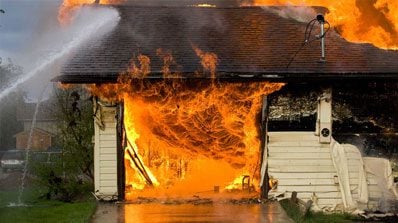Fire damage can strike at any moment, leaving behind destruction, emotional trauma, and financial stress. Whether it’s a small kitchen fire or a large-scale property blaze, the aftermath can be overwhelming. Understanding how fire damage occurs, how to prevent it, and how to recover efficiently is essential for every homeowner and business owner.
In this detailed guide, we’ll explore everything you need to know about fire damage—from its causes and types to effective restoration steps and prevention strategies.
What Is Fire Damage?
Fire damage refers to the destruction caused by flames, smoke, heat, and soot during or after a fire. It affects both the structure and contents of a property. Even small fires can cause significant smoke and soot damage, while larger ones may destroy entire buildings.
Fire doesn’t just burn materials—it alters them. Wood, plastic, metal, and fabrics react differently to heat and combustion, creating toxic residues that can linger long after the fire is extinguished.
Common Causes of Fire Damage
Fires can start for many reasons, often unexpectedly. Understanding the leading causes helps in preventing future incidents.
Cooking Accidents
Kitchen fires are the number one cause of household fires. Grease fires, unattended stoves, or overheated appliances can quickly escalate.
Electrical Malfunctions
Faulty wiring, overloaded circuits, or damaged electrical equipment often spark fires. Outdated or poorly installed systems increase the risk.
Heating Equipment
Space heaters, fireplaces, and furnaces can ignite flammable materials nearby. Blocked chimneys or lack of maintenance make heating fires common in colder months.
Smoking Indoors
Careless smoking habits, such as not properly extinguishing cigarettes, are a frequent cause of fire damage in homes.
Candles and Open Flames
Unattended candles or open flames can easily ignite curtains, furniture, or paper products.
Arson and Vandalism
Intentional fires are devastating, often causing severe property damage and emotional loss.
Natural Disasters
Wildfires and lightning strikes can also lead to large-scale fire damage, especially in dry or windy regions.
Types of Fire Damage
Not all fire damage is the same. Different sources and materials produce different types of destruction and require unique restoration techniques.
Flame Damage
This is the direct result of burning materials. It causes charring, melting, and the complete destruction of objects.
Smoke Damage
Smoke travels fast and can seep into walls, furniture, and ventilation systems. It leaves behind strong odors and residue that are hard to remove.
Soot Damage
Soot is a fine, black residue that results from incomplete combustion. It stains surfaces, corrodes metal, and can be hazardous to health.
Heat Damage
Even areas not directly touched by flames can suffer from high temperatures, causing discoloration or warping of materials.
Water Damage from Firefighting
Ironically, water used to extinguish flames can lead to secondary damage like mold growth, structural weakening, and ruined furnishings.
Immediate Steps to Take After Fire Damage
When a fire occurs, quick action is crucial. Here’s what you should do immediately after ensuring everyone’s safety:
Contact Emergency Services: Even if the fire seems small, always call firefighters.
Ensure Safety First: Do not enter the property until professionals declare it safe.
Document the Damage: Take photos and videos for insurance claims.
Notify Your Insurance Company: Report the incident as soon as possible.
Call a Fire Damage Restoration Company: Professional restoration experts can assess the damage and start cleanup quickly.
Secure the Property: Board up broken windows or doors to prevent theft or weather exposure.
Fire Damage Restoration Process
The fire damage restoration process involves several stages designed to return your property to its pre-fire condition. Here’s a breakdown:
Step 1: Assessment and Inspection
Experts inspect the site to determine the extent of damage, identifying what can be restored and what needs replacing.
Step 2: Board-Up and Roof Tarping
If the fire has compromised walls, roofs, or windows, the restoration team will secure the structure to prevent further damage.
Step 3: Water Removal and Drying
Water used in firefighting is extracted using industrial-grade equipment. Dehumidifiers and air movers ensure complete drying.
Step 4: Smoke and Soot Cleanup
Professionals use specialized techniques and cleaning agents to remove smoke residue, soot, and odors from walls, ceilings, and surfaces.
Step 5: Sanitization and Odor Removal
Advanced tools like ozone generators and air scrubbers help eliminate lingering smoke smells and harmful airborne particles.
Step 6: Repairs and Restoration
Finally, damaged materials such as drywall, flooring, or roofing are repaired or replaced. The goal is to make your home safe, clean, and comfortable again.
Health Risks Associated with Fire Damage
Fire damage isn’t just structural—it can affect your health too. Exposure to soot, smoke, and chemical residues poses serious risks:
Respiratory Issues: Breathing in smoke particles can cause coughing, wheezing, or chronic lung problems.
Skin and Eye Irritation: Soot and ash can irritate skin and eyes.
Toxic Fumes: Burning plastic or chemicals releases harmful toxins into the air.
Mold Growth: Water damage from firefighting can lead to mold within 48 hours.
Always wear protective gear when re-entering a fire-damaged property, and leave cleanup to professionals.
Fire Damage Prevention Tips
Preventing fires is always easier than dealing with their aftermath. Follow these simple but effective steps:
Install Smoke Alarms
Place smoke detectors in every bedroom, hallway, and living area. Test them monthly and replace batteries yearly.
Maintain Electrical Systems
Hire licensed electricians to inspect your wiring and outlets regularly. Avoid overloading circuits.
Be Cautious in the Kitchen
Never leave cooking unattended. Keep flammable items away from stoves and ovens.
Use Space Heaters Safely
Keep heaters at least three feet from combustible materials. Always turn them off before sleeping or leaving the house.
Store Flammable Materials Properly
Keep items like gasoline, paint thinner, and cleaning products in ventilated areas away from heat sources.
Have a Fire Extinguisher
Keep a working fire extinguisher in key areas such as the kitchen, garage, and near fireplaces.
Create a Fire Escape Plan
Practice an emergency exit plan with your family to ensure everyone knows how to evacuate safely.
The Importance of Professional Fire Damage Restoration
While it may be tempting to handle minor fire cleanup yourself, professional restoration is essential for several reasons:
Thorough Cleaning: Experts have the right tools and chemicals to remove soot and smoke residues effectively.
Odor Elimination: Smoke odor can linger for months if not treated properly.
Structural Safety: Professionals identify hidden damage that could compromise the building’s integrity.
Faster Recovery: Certified technicians follow proven processes that speed up restoration and reduce costs in the long run.
Insurance Support: Restoration companies often help with documentation and insurance claims.
Estimating Fire Damage Costs
The cost of restoring fire damage depends on several factors:
| Factor | Estimated Cost Range (USD) |
|---|---|
| Minor smoke damage | $2,000 – $6,000 |
| Moderate fire damage | $7,000 – $30,000 |
| Severe structural damage | $50,000+ |
| Complete rebuild | $100,000+ |
Note: Prices vary by region, size of property, and extent of damage.
Fire Damage and Insurance Claims
Dealing with insurance after a fire can be challenging. Here are some tips to simplify the process:
File Your Claim Quickly: Contact your insurance provider as soon as possible.
Document Everything: Photos, receipts, and professional reports support your claim.
Avoid Discarding Items: Keep damaged items until your adjuster inspects them.
Hire a Public Adjuster: If the claim is complex, a public adjuster can negotiate better coverage.
Keep Communication Records: Document all calls and emails with your insurance company.
Emotional and Psychological Recovery
Recovering from fire damage isn’t just about rebuilding walls—it’s also about healing emotionally. Fire disasters can cause stress, anxiety, and even post-traumatic symptoms. Seek support from friends, family, or professional counselors.
Many restoration companies also offer emotional support resources to help families recover mentally after property loss.
Key Takeaways
Fire damage includes destruction from flames, smoke, soot, and water.
The main causes are cooking accidents, electrical issues, heating equipment, and unattended flames.
Immediate action—contacting professionals and documenting damage—is critical.
Professional restoration ensures thorough cleanup, odor removal, and safe rebuilding.
Prevention measures like smoke alarms, regular inspections, and safety habits can save lives and property.
Final Thoughts
Fire damage can be devastating, but recovery is possible with the right steps and support. From understanding the causes to hiring professional restoration experts, every action helps bring your property—and peace of mind—back to normal.
If you ever experience a fire, remember: safety first, documentation second, and restoration third. The sooner you act, the faster you can rebuild your home and your life.





Leave a Reply